
Concept explainers
Draw structures corresponding to the following systematic names:
(a) (4E)-2, 4-Dimethyl-l, 4-hexadiene
(b) cis-3, 3-Dimethyl-4-propyl-l, 5-octadiene
(c) 4-Methyl-l, 2-pentadiene
(d) (3E, 5Z)-2, 6-Dimethyl-1, 3, 5, 7-octatetraene
(e) 3-Butyl-2-heptene
(f) trans-2, 2, 5, 5-Tetramethyl-3-hexene
a) (4E)-2, 4-Dimethyl-1, 4-hexadiene.
Interpretation:
The structure corresponding to the systematic name (4E)-2, 4-dimethyl-1, 4-hexadiene is to be drawn.
Concept introduction:
The longest carbon chain containing the double bond to be chosen. Based on the name of the parent compound–the alkene name ends with the suffix–alkene. The chain is to be numbered from the end that gives the lowest number to the carbon in double bond. Substituents are to be numbered according to their positions in the chain and listed alphabetically. The position of the double bond is indicated by giving the number of the first alkene carbon before the name of the parent name. If more than one double bond is present, their positions are indicated with the suffixes -diene, -triene and so on. The isomer that has the higher ranked groups on each carbon are on the same side of the double bond is said to have Z configuration. If the higher ranked groups are on opposite sides, the alkene is said to have E configuration.
To draw:
The structure corresponding to the systematic name (4E)-2, 4-dimethyl-1, 4-hexadiene.
Answer to Problem 38AP
The structure corresponding to the systematic name (4E)-2, 4-dimethyl-1, 4-hexadiene is
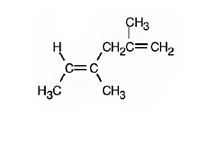
Explanation of Solution
The name shows that the longest carbon chain should contain six carbons with two double bonds between C2 & C3 and C4 & C5. There should be two methyl substituents one on C2 and other on C4. Further higher ranked groups on each carbon should be in the opposite sides of the double bonds.
The structure corresponding to the systematic name (4E)-2, 4-dimethyl-1, 4-hexadiene is

b) cis-3, 3-Dimethyl-4-isopropyl-1, 5-octadiene.
Interpretation:
The structure corresponding to the systematic name cis-3, 3-dimethyl-4-isopropyl-1, 5-octadiene is to be drawn.
Concept introduction:
The longest carbon chain containing the double bond to be chosen. Based on the name of the parent compound–the alkene name ends with the suffix–ene. The chain is to be numbered from the end that gives the lowest number to the carbon in double bond. Substituents are to be numbered according to their positions in the chain and listed alphabetically. The position of the double bond is indicated by giving the number of the first alkene carbon before the name of the parent name. If more than one double bond is present, their positions are indicated with the suffixes -diene, -triene and so on. The isomer that has similar groups on each carbon on the same side of the double bond is called as the cis isomer. The isomer that has similar groups on each carbon on the opposite side of the double bond is called as thetrans isomer.
To draw:
The structure corresponding to the systematic name cis-3, 3-dimethyl-4-isopropyl-1, 5-octadiene.
Answer to Problem 38AP
The structure corresponding to the systematic name cis-3, 3-dimethyl-4-isopropyl-1, 5-octadiene is
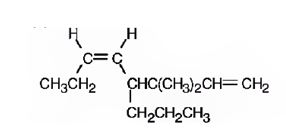
Explanation of Solution
The name shows that the longest carbon chain should contain eight carbons with two double bonds between C1 & C2 and C5 & C6. There should be two methyl substituents on C3 and an isopropyl group on C4. Further similar groups in each carbon should be on the same sides of the double bonds.
The structure corresponding to the systematic name cis-3, 3-dimethyl-4-isopropyl-1, 5-octadiene is

c) 4-Methyl-1, 2-pentadiene.
Interpretation:
The structure corresponding to the systematic name4-methyl-1, 2-pentadiene is to be drawn.
Concept introduction:
The longest carbon chain containing the double bond to be chosen. Based on the name of the parent compound–the alkene name ends with the suffix–ene. The chain is to be numbered from the end that gives the lowest number to the carbon in double bond. Substituents are to be numbered according to their positions in the chain and listed alphabetically. The position of the double bond is indicated by giving the number of the first alkene carbon before the name of the parent name. If more than one double bond is present, their positions are indicated with the suffixes -diene, -triene and so on.
To draw:
The structure corresponding to the systematic name 4-methyl-1, 2-pentadiene.
Answer to Problem 38AP
The structure corresponding to the systematic name 4-methyl-1, 2-pentadiene is

Explanation of Solution
The name shows that the longest carbon chain should contain five carbons with two double bonds between C1 & C2 and C2 & C3. There should be amethyl substituent on C4.
The structure corresponding to the systematic name 4-methyl-1, 2-pentadiene is

d) (3E, 5Z)-2, 6-Dimethyl-1, 3, 5, 7-octatetraene.
Interpretation:
The structure corresponding to the systematic name (3E, 5Z)-2, 6-dimethyl-1, 3, 5, 7-octatetraene is to be drawn.
Concept introduction:
The longest carbon chain containing the double bond to be chosen. Based on the name of the parent compound–the alkene name ends with the suffix–ene. The chain is to be numbered from the end that gives the lowest number to the carbon in double bond. Substituents are to be numbered according to their positions in the chain and listed alphabetically. The position of the double bond is indicated by giving the number of the first alkene carbon before the name of the parent name. If more than one double bond is present, their positions are indicated with the suffixes -diene, -triene and so on. The isomer that has the higher ranked groups on each carbon are on the same side of the double bond is said to have Z configuration. If the higher ranked groups are on opposite sides, the alkene is said to have E configuration.
To draw:
The structure corresponding to the systematic name (3E, 5Z)-2, 6-dimethyl-1, 3, 5, 7-octatetraene.
Answer to Problem 38AP
The structure corresponding to the systematic name (3E, 5Z)-2, 6-dimethyl-1, 3, 5, 7-octatetraene is
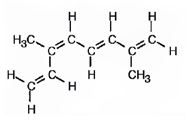
Explanation of Solution
The name shows that the longest carbon chain should contain eight carbons with two double bonds between C2 & C3 and C6 & C7. There should be two methyl substituents one on C2 and other on C6. Further higher ranked groups on C2 & C3 must be placed on the opposite sides of the double bond. The higher ranked groups on C6 & C7 must be placed on the same side of the double bond.
The structure corresponding to the systematic name (3E, 5Z)-2, 6-dimethyl-1, 3, 5, 7-octatetraene is

e) 3-Butyl-2-heptene.
Interpretation:
The structure corresponding to the systematic name3-butyl-2-heptene is to be drawn.
Concept introduction:
The longest carbon chain containing the double bond to be chosen. Based on the name of the parent compound–the alkene name ends with the suffix–ene. The chain is to be numbered from the end that gives the lowest number to the carbon in double bond. Substituents are to be numbered according to their positions in the chain and listed alphabetically. The position of the double bond is indicated by giving the number of the first alkene carbon before the name of the parent name. If more than one double bond is present, their positions are indicated with the suffixes -diene, -triene and so on.
To draw:
The structure corresponding to the systematic name 3-butyl-2-heptene.
Answer to Problem 38AP
The structure corresponding to the systematic name 3-butyl-2-heptene is
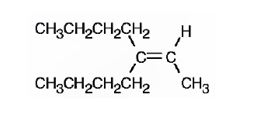
Explanation of Solution
The name shows that the longest carbon chain should contain seven carbons with a double bond between C2 & C3. There should be a butyl substituent on C3.
The structure corresponding to the systematic name 3-butyl-2-heptene is

f) trans-2, 2, 5, 5-Tetramethyl-3-hexene.
Interpretation:
The structure corresponding to the systematic name trans-2, 2, 5, 5-tetramethyl-3-hexene is to be drawn.
Concept introduction:
The longest carbon chain containing the double bond to be chosen. Based on the name of the parent compound–the alkene name ends with the suffix–ene. The chain is to be numbered from the end that gives the lowest number to the carbon in double bond. Substituents are to be numbered according to their positions in the chain and listed alphabetically. The position of the double bond is indicated by giving the number of the first alkene carbon before the name of the parent name. If more than one double bond is present, their positions are indicated with the suffixes -diene, -triene and so on. The isomer that has similar groups on each carbon on the same side of the double bond is called as the cis isomer. The isomer that has similar groups on each carbon on the opposite side of the double bond is called as the trans isomer.
To draw:
The structure corresponding to the systematic name trans-2, 2, 5, 5-tetramethyl-3-hexene.
Answer to Problem 38AP
The structure corresponding to the systematic name trans-2, 2, 5, 5-tetramethyl-3-hexene is
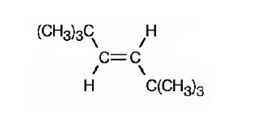
Explanation of Solution
The name shows that the longest carbon chain should contain six carbons with a double bond between C3 & C4. There should be four methyl substituents two on C3 and two on C5. Further similar groups in each carbon should be on the opposite sides of the double bonds.
The structure corresponding to the systematic name trans-2,2,5,5-tetramethyl-3-hexene is

Want to see more full solutions like this?
Chapter 7 Solutions
EP ORGANIC CHEMISTRY,24 MONTH-OWLV2
- Predict the intermediate 1 and final product 2 of this organic reaction: NaOMe H+ + 1 2 H H work up You can draw 1 and 2 in any arrangement you like. Note: if either 1 or 2 consists of a pair of enantiomers, just draw one structure using line bonds instead of 3D (dash and wedge) bonds at the chiral center. Click and drag to start drawing a structure. X $ dmarrow_forwardPredict the major products of this organic reaction: 1. NaH (20°C) 2. CH3Br ? Some notes: • Draw only the major product, or products. You can draw them in any arrangement you like. • Be sure to use wedge and dash bonds where necessary, for example to distinguish between major products that are enantiomers. • If there are no products, just check the box under the drawing area. No reaction. Click and drag to start drawing a structure. G Crarrow_forwardPredict the major products of this organic reaction: 1. LDA (-78°C) ? 2. Br Some notes: • Draw only the major product, or products. You can draw them in any arrangement you like. . • Be sure to use wedge and dash bonds where necessary, for example to distinguish between major products that are enantiomers. • If there are no products, just check the box under the drawing area. No reaction. Click and drag to start drawing a structure. Xarrow_forward
- Please draw the structuresarrow_forwardDraw the missing intermediates 1 and 2, plus the final product 3, of this synthesis: 0 1. Eto 1. Eto- 1 2 2. MeBr 2. EtBr H3O+ A 3 You can draw the three structures in any arrangement you like. Explanation Check Click and drag to start drawing a structure.arrow_forwardDraw the missing intermediate 1 and final product 2 of this synthesis: 1. MeO- H3O+ 1 2 2. PrBr Δ You can draw the two structures in any arrangement you like. Click and drag to start drawing a structure.arrow_forward
- What is the differences between: Glyceride and phosphoglyceride Wax and Fat Soap and Fatty acid HDL and LDL cholesterol Phospho lipids and sphingosine What are the types of lipids? What are the main lipid components of membrane structures? How could lipids play important rules as signaling molecules and building units? The structure variety of lipids makes them to play significant rules in our body, conclude breifly on this statement.arrow_forwardWhat is the differences between DNA and RNA for the following: - structure - function - type What is the meaning of: - replication - transcription - translation show the base pair connection(hydrogen bond) in DNA and RNAarrow_forwardWhat is the IP for a amino acid- give an example what are the types of amino acids What are the structures of proteins The N-Terminal analysis by the Edman method shows saralasin contains sarcosine at the N-terminus. Partial hydrolysis of saralasin with dilute hydrochloric acid yields the following fragments: Try-Val-His Sar-Arg-Val His-Pro-Ala Val- Tyr- Val Arg-Val-Tyr What is the structure of saralasin?arrow_forward
- What is the IP for a amino acid- give an example what are the types of amino acids What are the structures of proteins The N-Terminal analysis by the Edman method shows saralasin contains sarcosine at the N-terminus. Partial hydrolysis of saralasin with dilute hydrochloric acid yields the following fragments: Try-Val-His Sar-Arg-Val His-Pro-Ala Val- Tyr- Val Arg-Val-Tyr What is the structure of saralasin?arrow_forward> aw the missing intermediates 1 and 2, plus the final product 3, of this synthesis: 1. Eto 1. EtO¯ H3O+ 1 2 2. PrBr 2. PrBr Δ You can draw the three structures in any arrangement you like. 3 Click and drag to start drawing a structure. Explanation Check 2025 McGraw Hill LLC. All Rights Reserved. Terms of Use Privacarrow_forwardThere are various factors that affect an equilibrium. Give 3 of these factors and explain using examples andequations how an equilibrium is affected by these factors. Please remember that this is a communication question so that you are communicating your understanding of the factors that affect and equilibrium.arrow_forward
 ChemistryChemistryISBN:9781305957404Author:Steven S. Zumdahl, Susan A. Zumdahl, Donald J. DeCostePublisher:Cengage Learning
ChemistryChemistryISBN:9781305957404Author:Steven S. Zumdahl, Susan A. Zumdahl, Donald J. DeCostePublisher:Cengage Learning ChemistryChemistryISBN:9781259911156Author:Raymond Chang Dr., Jason Overby ProfessorPublisher:McGraw-Hill Education
ChemistryChemistryISBN:9781259911156Author:Raymond Chang Dr., Jason Overby ProfessorPublisher:McGraw-Hill Education Principles of Instrumental AnalysisChemistryISBN:9781305577213Author:Douglas A. Skoog, F. James Holler, Stanley R. CrouchPublisher:Cengage Learning
Principles of Instrumental AnalysisChemistryISBN:9781305577213Author:Douglas A. Skoog, F. James Holler, Stanley R. CrouchPublisher:Cengage Learning Organic ChemistryChemistryISBN:9780078021558Author:Janice Gorzynski Smith Dr.Publisher:McGraw-Hill Education
Organic ChemistryChemistryISBN:9780078021558Author:Janice Gorzynski Smith Dr.Publisher:McGraw-Hill Education Chemistry: Principles and ReactionsChemistryISBN:9781305079373Author:William L. Masterton, Cecile N. HurleyPublisher:Cengage Learning
Chemistry: Principles and ReactionsChemistryISBN:9781305079373Author:William L. Masterton, Cecile N. HurleyPublisher:Cengage Learning Elementary Principles of Chemical Processes, Bind...ChemistryISBN:9781118431221Author:Richard M. Felder, Ronald W. Rousseau, Lisa G. BullardPublisher:WILEY
Elementary Principles of Chemical Processes, Bind...ChemistryISBN:9781118431221Author:Richard M. Felder, Ronald W. Rousseau, Lisa G. BullardPublisher:WILEY





